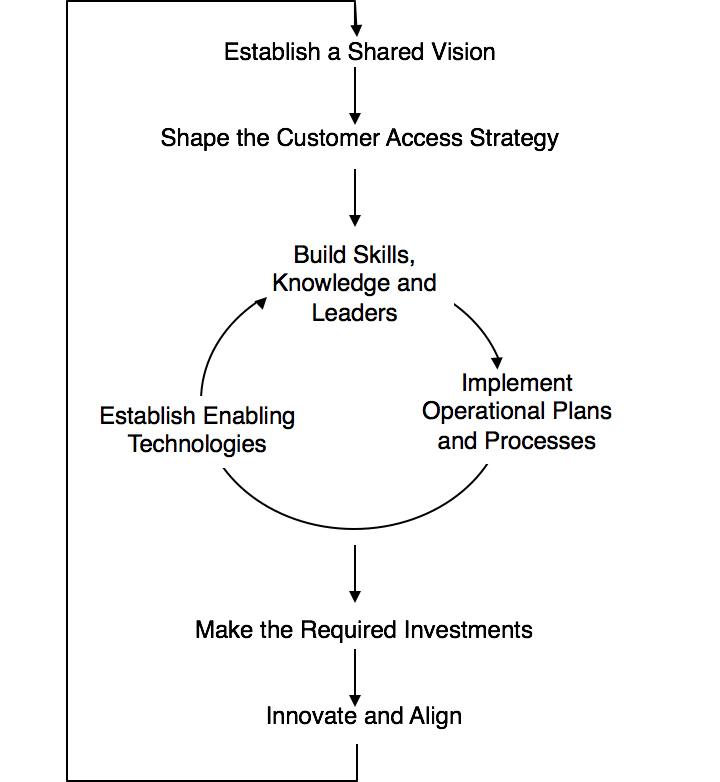I'm hearing from many of you that you're updating your customer service strategies for the new year, given all the changes in technology, the business landscape, and economy. But a common question keeps coming up: What should we include? What topics do we need to cover? The difference between industry leaders and those struggling to keep pace often lies in their approach to strategic customer service planning, so let's break this down into manageable components.
Here's a simple, effective model for developing your strategy. It consists of seven core components that will help define your organization's customer service direction.

The first step is to define your vision for customer service. Where do you want to go? What is your vision and mission, and what are the values that will guide every aspect of customer service? I love REI's mission, which also serves as its customer service vision: "We inspire, educate, and outfit for a lifetime of outdoor adventure and stewardship." Come up with something that both inspires and recognizes the enormous potential of customer service.
Your customer access strategy is likely already in place, whether documented or not. It's the blueprint for how customers interact with your organization. Here are the 10 essential components to consider:
- Customer segments - Who are you serving?
- Types of Interactions - Which services do they need?
- Access channels - How do they reach you?
- Hours of operation - When are you available?
- Objectives for accessibility - How easy is it to connect?
- Routing - How do inquiries flow?
- Required resources - What do you need to deliver?
- Required information - Which data supports service?
- Analysis/improvement - How do you measure and enhance?
- Guidelines for new services - How do you expand offerings?
The critical question is: Does your current access strategy effectively support your overall customer service vision? If not, it's time for a tune-up.
The Big 3: People, Processes, Technology
These three foundational elements work together to bring your strategy to life:
People:
- Build a comprehensive training program that develops both technical and soft skills.
- Create clear career pathways for service team members.
- Develop leadership capabilities at all levels.
Consider how companies like USAA invest in customer service training, with employees deeply learning and applying the company's service philosophy.
Processes:
- Design workflows that prioritize customer convenience.
- Implement quality assurance frameworks.
- Create feedback loops for continuous improvement.
Southwest Airlines builds service processes to empower front-line employees to make decisions that do not require multiple levels of approval.
Technology:
- Select tools that enhance rather than complicate service delivery.
- Ensure systems integrate seamlessly.
- Plan for future technological advances.
Consider how Trader Joe's or Costco keeps their technology focus on enhancing, not replacing, human interaction.
Once you've outlined your resource requirements through the previous steps, it's time to put numbers to your strategy. This means identifying both immediate operational needs and long-term investments that will support your vision.
The final step is to innovate and align. Customer expectations evolve rapidly, and your competitors continue to raise the bar. This step creates a feedback loop, taking you back to review and refine your vision, access strategy, core components, and investments.
Making It Work: Four Critical Success Factors
Organizations that excel in customer service don't just have great strategies; they execute them effectively. Here's what sets them apart:
Strategic Visibility
Your strategy must be a living document that guides daily decisions and priorities. The best organizations reference their strategy regularly in leadership meetings, team discussions, and decision-making processes.
Cross-Organizational Collaboration
Effective strategies aren't created in silos. They require input and buy-in from across the organization, from front-line staff to C-suite executives. This collaborative approach ensures the strategy reflects real-world needs and challenges.
Customer-Focused Culture
Strong cultures are built on clear principles. Consider how Ritz Carlton's motto, "We are ladies and gentlemen serving ladies and gentlemen," or FedEx's Purple Promise, "I will make every FedEx experience outstanding," guide their service delivery.
Employee Engagement
Research consistently shows that engaged employees deliver better customer experiences. Organizations with strong customer service strategies typically have higher employee engagement levels, creating a virtuous cycle of improvement.
Strategic planning doesn't have to be complicated. Take a moment now to assess your current approach against these components. Where are the gaps? Which areas need strengthening? By tackling these questions thoughtfully, you'll build a customer service operation that not only handles today's challenges but is ready for whatever tomorrow brings.
Brad Cleveland is a senior advisor and former CEO of the International Customer Management Institute (ICMI), now part of Informa.